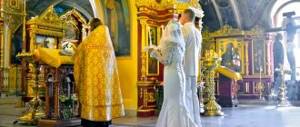Who can be a witness at a wedding and who cannot?
The function of witnesses (guarantors) at a wedding is not only to help the newlyweds during the ceremony.
They become spiritual mentors of the new family, who help the newlyweds, over many years of marriage, successfully cope with difficulties, overcome conflict situations, and guide the family union with wise advice and instructions. The choice of guarantors for a wedding must be approached responsibly, guided by common sense. Witnesses can be a husband and wife who have been in a strong, legal marriage for a long time, who are authorities for both newlyweds. If among the newlyweds you know there is no such married couple, then close friends or relatives of the bride and groom are invited for the wedding ceremony
It is important to remember that if the guarantors are not married before the sacrament, then after the ceremony they will become spiritual relatives and will not be allowed to enter into a church marriage
Divorced spouses cannot be witnesses at a wedding. They were unable to maintain their family union and, according to church canons, will become bad spiritual mentors to the newlyweds. It is forbidden to hire men and women living in a civil marriage as wedding assistants. Marriage unions not registered in the registry office, formed in defiance of the sacred commandments, are not approved by the Orthodox Church.
Ancient traditions and rules of church ritual
Traditions and rules of church weddings have remained virtually unchanged over time. Depending on the location of the sacrament, the ceremony lasts from 40 minutes in the parish church to 60 minutes in the monastery. All participants in the sacrament must be baptized or undergo the rite of baptism, otherwise they are not allowed to attend the wedding. A few days before the sacrament, you need to go to church: confess, take communion. Immediately before the ceremony, you cannot eat or have sex.
According to the canons of the Orthodox Church, during a wedding the witness must be dressed in a dress or skirt that covers her knees, and her head must be covered with a scarf or scarf. Deep necklines, bare shoulders, and overly revealing outfits are strictly prohibited for women. The witness is in the church without a headdress. If these rules are violated, the clergyman may not allow the guarantors to participate in the ceremony or even refuse to perform the sacrament.
According to tradition, the church ceremony takes place in several stages:
- Engagement. At the entrance to the church, the clergyman conducting the wedding blesses the newlyweds three times, reads prayers, and hands over lighted candles and rings. After the betrothal ritual, the newlyweds officially become the bride and groom.
- Wedding. The engaged couple goes to the center of the church and stands in front of the lectern on a white towel embroidered with prayers. Witnesses stand on either side of the bride and groom. The priest begins the ceremony: he reads prayers, places crowns on the heads of the newlyweds, or they are held by guarantors. Then the bride and groom taste wine and exchange sacred vows. The ceremony ends with a procession around the lectern three times, symbolizing the entry into a new family life. The priest takes off the crowns and blesses the newly made spouses.
- Permission of the crowns. After the wedding, a prayer begins containing wishes, prayers to God to preserve the marital union for many years, to bless the newlyweds in family life. At the end of the prayer, the priest conducts the dismissal: he takes the candles from the spouses, congratulates them on the joy of receiving the blessing of the union from the Lord, and takes them to the pulpit so that the young spouses can kiss the icons of Christ and the Mother of God.
- Thanksgiving prayer. At the end of the wedding, a thanksgiving prayer begins on the pulpit in front of the royal gates, after which all those present are blessed to leave the temple. Church bells begin to ring, announcing common joy and grace.
The church wedding of the newlyweds is currently taking place, including all four stages. During the ceremony, photography and video recording of the process are allowed. Close relatives and guests of the newlyweds can attend the ceremony and observe the sacrament being performed. Watch the video for a beautiful wedding ceremony of a young couple after the wedding:
Rules
Particular attention is paid not only to the behavior of witnesses during the ceremony, but also to the period of preparation for the wedding. What do the successors do before the sacrament? They need to take communion the day before, confess, and on the day of the wedding fast and renounce carnal pleasures. During the ceremony, witnesses, like other guests, must adhere to certain rules of behavior:
- You can't be late. The guarantors arrive at the church in advance and take their places near the newlyweds;
- Before the ceremony, mobile phones are turned off;
- You cannot talk or laugh loudly in church;
- They do not turn their backs to the iconostasis in church;
- On the wedding day they pray only for the happiness and health of the newlyweds. To light candles for the health of relatives or for the repose of the deceased, you should choose a different time;
- You should not sit on benches in church during services. Seating is reserved for sick and infirm people only.
Important! All wedding participants must be baptized or undergo baptism in advance. After the ceremony in the temple, the newlyweds often arrange a banquet for the guests
During the celebration, it is customary for the successors to behave calmly and humbly. Heavy drinking of alcohol, dancing and wild merriment on the part of witnesses are not welcome on this day.
After the ceremony in the temple, the newlyweds often arrange a banquet for the guests. During the celebration, it is customary for the successors to behave calmly and humbly. Heavy drinking of alcohol, dancing and wild fun on the part of witnesses are not welcome on this day.
Wedding in the Orthodox Church - rules
The ceremony is carried out according to certain rules:
- The wedding is carried out in the presence of a marriage certificate.
- The husband becomes the head of the family, he is obliged to honor his wife, protect and cherish.
- It becomes the husband's responsibility to maintain contact with the church.
- A wife must listen to her husband and recognize his leadership.
A completed wedding is not subject to cancellation or revision, but with special permission, dethronement or divorce is carried out for the following reasons:
- spouse's adultery
- mental illness of the spouse (if at the time of the wedding the person is already ill, this is grounds for refusing to marry the couple).
If the former spouse is alive and well, a second wedding is possible with the permission of the bishop. A petition is written indicating the reasons for the divorce, documents are attached (any church will tell you more, and they will also give you a list of necessary documents).
You should know that the bishop’s permission is given to persons from dissolved unions only out of tolerance for the weakness of today’s Christians:
- the wedding is carried out in the absence of obstacles (previously, an engagement was held, the couple’s intention to tie the knot was announced publicly - so that anyone who knows about the circumstances preventing this could report it);
- a person can get married three times, a third ceremony is allowed extremely rarely;
- the young and witnesses must be baptized and wear a cross during the ceremony.
Church marriages between Christians are allowed, one of whom is not Orthodox, and the baptism of children into Orthodoxy is mandatory:
- If the person getting married does not know whether he has been baptized, he must tell the priest about it.
- The couple informs the priest of the temple about their intention to get married.
- To receive a positive decision from the church to perform the ceremony, the couple must agree to give birth to children and raise them in Orthodoxy.
- There are age restrictions: men from 18 years old, women from 16 years old.
- You cannot obtain a wedding permit if:
- not baptized;
- the bride and groom are relatives, even if the relationship is distant;
- one of the spouses has a previous marriage or an established civil relationship that is reliably known.
Pregnancy of a young woman or lack of consent and blessing of parents are not an obstacle to the ceremony.
This is interesting: Wedding rules in the Orthodox Church - we describe them in detail
Is it permissible to perform the sacrament over
Unbaptized
People who have not been baptized are not members of the Church, and therefore do not have the right to participate in the Sacraments, including getting married.
Godfathers
A marriage union between a child's godfather and his natural father or mother is expressly prohibited. But about the possibility of creating a family between two godparents of one child, opinions differ. Article 11 of the Nomocanon prohibits such marriages. In 1730, the reliability of this clause was questioned due to the unknown author of this rule. And in 1837, the Holy Synod issued a Decree stating that the creation of a family between godparents takes place.
There is still no consensus on this issue. Such issues are resolved by the ruling bishop on an individual basis.
Catholic and Orthodox
A Catholic and an Orthodox woman can marry each other if two conditions are met:
- The sacrament will be performed by an Orthodox priest and in an Orthodox church.
- The couple will raise their children in Orthodoxy.
Who can be a witness at a wedding and who cannot?
The function of witnesses (guarantors) at a wedding is not only to help the newlyweds during the ceremony. They become spiritual mentors of the new family, who help the newlyweds, over many years of marriage, successfully cope with difficulties, overcome conflict situations, and guide the family union with wise advice and instructions. The choice of guarantors for a wedding must be approached responsibly, guided by common sense.
Witnesses can be a husband and wife who have been in a strong, legal marriage for a long time, who are authorities for both newlyweds. If among the newlyweds you know there is no such married couple, then close friends or relatives of the bride and groom are invited for the wedding ceremony
It is important to remember that if the guarantors are not married before the sacrament, then after the ceremony they will become spiritual relatives and will not be allowed to enter into a church marriage
Divorced spouses cannot be witnesses at a wedding. They were unable to maintain their family union and, according to church canons, will become bad spiritual mentors to the newlyweds. It is forbidden to hire men and women living in a civil marriage as wedding assistants. Marriage unions not registered in the registry office, formed in defiance of the sacred commandments, are not approved by the Orthodox Church.
Ancient traditions and rules of church ritual
Traditions and rules of church weddings have remained virtually unchanged over time. Depending on the location of the sacrament, the ceremony lasts from 40 minutes in the parish church to 60 minutes in the monastery. All participants in the sacrament must be baptized or undergo the rite of baptism, otherwise they are not allowed to attend the wedding. A few days before the sacrament, you need to go to church: confess, take communion. Immediately before the ceremony, you cannot eat or have sex.
According to the canons of the Orthodox Church, during a wedding the witness must be dressed in a dress or skirt that covers her knees, and her head must be covered with a scarf or scarf. Deep necklines, bare shoulders, and overly revealing outfits are strictly prohibited for women. The witness is in the church without a headdress. If these rules are violated, the clergyman may not allow the guarantors to participate in the ceremony or even refuse to perform the sacrament.
According to tradition, the church ceremony takes place in several stages:
- Engagement. At the entrance to the church, the clergyman conducting the wedding blesses the newlyweds three times, reads prayers, and hands over lighted candles and rings. After the betrothal ritual, the newlyweds officially become the bride and groom.
- Wedding. The engaged couple goes to the center of the church and stands in front of the lectern on a white towel embroidered with prayers. Witnesses stand on either side of the bride and groom. The priest begins the ceremony: he reads prayers, places crowns on the heads of the newlyweds, or they are held by guarantors. Then the bride and groom taste wine and exchange sacred vows. The ceremony ends with a procession around the lectern three times, symbolizing the entry into a new family life. The priest takes off the crowns and blesses the newly made spouses.
- Permission of the crowns. After the wedding, a prayer begins containing wishes, prayers to God to preserve the marital union for many years, to bless the newlyweds in family life. At the end of the prayer, the priest conducts the dismissal: he takes the candles from the spouses, congratulates them on the joy of receiving the blessing of the union from the Lord, and takes them to the pulpit so that the young spouses can kiss the icons of Christ and the Mother of God.
- Thanksgiving prayer. At the end of the wedding, a thanksgiving prayer begins on the pulpit in front of the royal gates, after which all those present are blessed to leave the temple. Church bells begin to ring, announcing common joy and grace.
The church wedding of the newlyweds is currently taking place, including all four stages. During the ceremony, photography and video recording of the process are allowed. Close relatives and guests of the newlyweds can attend the ceremony and observe the sacrament being performed. Watch the video for a beautiful wedding ceremony of a young couple after the wedding:
Who to choose as assistants to the bride and groom?
In the modern world, many do not thoroughly observe all the rules and traditions of church rites. However, a wedding is a special sacrament. In order for the ceremony to become more than just a tribute to fashion, it is important to follow church canons and pay special attention to the choice of successors.
For this role, only sincerely believing Orthodox people are invited, who can become the spiritual mentors of the spouses. Witnesses must be allowed to enter the young couple's house. It is important that there is a close, trusting relationship between spouses and guarantors.
It is best to choose a pious married couple as successors, who can become an authority for the young. If there are no such people in your close circle, the role of friend and friend is offered to close friends.
It is also worth considering that during the ceremony, the guarantors hold crowns over the heads of the bride and groom, so it is worth paying attention to the height and physical characteristics of the candidates for the role of witnesses. After all, the wedding ceremony lasts about an hour, and the crown is quite difficult to hold in weight for a long time.
Important! A couple who was not married before participating in the ceremony will subsequently not be able to get married. By taking on the role of guarantors, witnesses become spiritual relatives.
The church prohibits a number of persons from taking on the duties of successors. These include:
- divorced people;
- a couple living in a civil marriage;
- parents of the bride and groom;
- representatives of other religions;
- unbaptized.
Recommendations for selection
The choice of witnesses for a wedding should be taken with full responsibility. Although the role of guarantors has changed somewhat over the years, having lost their official status, these people still accept obligations to God for the spiritual support of the future family. Not all candidates are approved by the church.
Can spouses be witnesses at a wedding?
Spouses of a traditional type of marriage (a man and a woman) living in a legal marriage can be witnesses at the wedding of the newlyweds. The church is not allowed to take a couple living in a civil marriage as witnesses.
Who should not be taken
But there are many more prohibitions here; you cannot call friends:
- atheists and representatives of other religions;
- parents of newlyweds;
- living in an unregistered marriage, since the church is against such unions;
- divorced people, because they could not save their family, so they will not make worthy mentors;
- unbaptized.
Preparation for the sacrament of wedding
Choosing a church, communicating with a priest
To decide where to get married, you can go to different churches and choose the church where you feel most comfortable. For a magnificent, solemn ceremony, a large cathedral is suitable, for a quiet, secluded ceremony - a small church. Since the priest is an important character in the ritual, it is worth taking a responsible approach to his choice.
You must register for the wedding ceremony in advance (several weeks in advance). It is also worth discussing with the priest in advance all the issues: the duration of the wedding, what you need to bring with you, whether photography can be carried out, etc. It is worth considering that this is a paid ceremony, but in some churches its exact cost is established, in others voluntary donations are provided. This issue should also be discussed with the priest. Moreover, “additional services” are often provided, for example, bell ringing, church choir.
Selection of guarantors
Two guarantors (witnesses) are usually chosen from close relatives. It is worth considering that they must be baptized. It is not allowed to take divorced spouses or a couple living in an illegal, “civil” marriage as guarantors. Their spiritual responsibilities are similar to those of godparents: they must spiritually guide the family they are creating. Therefore, it is not customary to invite young people who are not familiar with married life to be guarantors. If difficulties arise when searching for witnesses, it is possible to carry out the sacrament of wedding without them.
Wedding ceremony in the Orthodox Church: what you need to know about the rules of the sacrament
Choosing an outfit
- Bride The bride's wedding dress should not be higher than her knees, should cover her shoulders and preferably her arms, and should not have a deep neckline (you can use long gloves, a cape, a bolero, an openwork shawl, a stole, etc.). It is advisable to give preference to light colors along with dark and bright ones (purple, blue, black) should be abandoned. Sundresses and trouser suits are not suitable for the ceremony. The bride must cover her head. Considering that during the ceremony the newlyweds wear church crowns (crowns), you should not cover the bride’s head with a large hat, as it will look inappropriate.
You can wear any shoes, but when choosing them, you should take into account that you will have to stand in them for quite a long time, so it is better to avoid uncomfortable high-heeled shoes. To decide on a hairstyle, it is advisable to check with the priest in advance whether the crowns will be placed on the head or will be held by guarantors. The bride's makeup should not be too noticeable; it is also worth remembering that it is forbidden to kiss a crown, cross, or icon with painted lips.It is believed that a wedding dress cannot be given or sold. It must be stored together with baptismal shirts, wedding candles, and icons.
- Groom For a wedding, the groom will wear a formal suit. There are no special prohibitions regarding the color of the suit. You should not come to church in casual, denim, or sportswear. The groom should not have a hat.
- Guests Guests, entering the temple, must comply with the requirements for all parishioners: for women - closed clothing, hats, trouser suits are not recommended, for men - formal clothing, without a headdress.
In addition, all participants and those present at the wedding ceremony: the bride, groom, guarantors and guests must wear crosses.
What to prepare for the ceremony
For the wedding you will need: - rings, which must be given to the priest before the ceremony for consecration; - wedding candles; — wedding icons (images of Christ and the Virgin Mary); - a white towel (the newlyweds will stand on it during the ceremony); - two scarves (to hold candles).
The towel on which the bride and groom stood during the wedding in the temple symbolizes the path of life, so it must be kept and not given to anyone. You should also store wedding candles, which can be lit during difficult childbirth or illness of children.
Photographer's choice
It is important to note that making a video or photographing a wedding ceremony is not allowed in all churches. Therefore, it is worth discussing this issue with the priest in advance.
Considering that the lighting in churches is specific, it is advisable to choose a professional photographer who will take into account the nuances of shooting, will be able to choose the right angles, and take high-quality photographs that convey the atmosphere of the temple and the grandeur of the wedding ceremony.
Dress code
The wedding ceremony requires an appropriate appearance not only from the bride and groom, but also from their successors. When it comes to bridesmaid attire, it definitely can't be pants. The witness's clothing should be modest. Skirts and dresses above the knee are not allowed. Shoulders and neckline should be covered with a cape or poncho.
Important! Witnesses must wear a cross. As a last resort, wear it during the ceremony.
A headdress is required for the witness, as well as for other women present. The successor should also pay attention to the color of the dress. It should not match the color of the bride's wedding dress. The best attire for a witness is a solid suit or shirt and trousers, but black should be avoided. Males are not allowed to wear a headdress in the temple.
How is the Sacrament of Marriage performed?
Nowadays it is customary to first visit the registry office, because priests require a marriage certificate. This is explained by the fact that there are cases when a wedding cannot be performed (priests are deceived into going to the registry office, but they themselves separate some time after the wedding, or have another family).
Usually couples come to the temple dressed up, the bride wears a white dress. But sometimes priests also have to marry older people who have lived together for many years. It even happens that a wedding takes place at home, because one of the spouses can no longer get out of bed. There is also a ceremony for people marrying for the second time. All these ranks have different ranks.
The rank consists of three parts:
- Engagements.
- Weddings.
- Common bowl.
The wedding ceremony begins with betrothal. Before this, the priest asks whether the groom takes this bride by good will, and whether he has promised to another girl. The same question is asked to the bride. Newlyweds should have rings with them. The priest takes them to the altar to bless them. There is a folk custom - to lay a white towel under the feet of those getting married. This is a sign of pure family relationships.
The bride and groom put rings on each other. This is a symbol taken from the culture of Ancient Rome, meaning voluntary slavery. This means that the husband and wife no longer belong to each other, but only to the spouse. The priest reads prayers for family peace and prosperity, love and mutual understanding between spouses, for the gift of children and long life. Then the priest blesses them with crowns, which imply a reward for chastity before marriage. The Apostle and the Gospel are read. Then the prayer “Our Father” is sung.
Then a cup of wine is brought out, which the bride and groom must drink. This symbolizes the future trials they must endure together. In fact, the wedding was reminiscent of the ancient supper of love - agape.
Sometimes the crowns are held over the heads of guarantors. Previously, they played the role of witnesses who signed the church book. They were called "best men".
Then the couple, holding hands, led by the priest, walk around the lectern while singing troparions (“Isaiah rejoice”, etc.). Sometimes the guarantors follow them, holding crowns over their heads.
The wedding of second marriages is different in that there is no betrothal. And the wedding of those spouses who have lived together for many years is different in that it contains a prayer of repentance, and there is no prayer for the gift of children. And these rites are much shorter than the main one.
After the wedding, husband and wife become one flesh.
What should you bring to your wedding?
The bride and groom must have with them:
- icon of Christ;
- icon of the Blessed Virgin Mary;
- wedding candles;
- wedding rings;
- white towel.
All this can be purchased at the church store. Before the wedding, it is good to undergo the Sacrament of Confession and Communion.
Who should not have a wedding?
According to the rules of the Orthodox Church, you cannot get married:
- those who are already married, civil or church;
- blood relatives in direct or indirect line;
- godson with godparents;
- persons under eighteen years of age;
- those who have not undergone the Sacrament of baptism;
- clergy, starting from the subdeaconal rank;
- those who have already been in civil marriages more than three times;
- those who have accepted the monastic rank;
- persons who have changed their gender;
- mentally incompetent persons;
- adoptive parents with their adopted children.
It is also not allowed to get married without the consent of the bride or groom.
When can I get married?
Weddings do not take place on one of the four fasts, or on the eve of one-day fasts and holidays (including Sundays). Those. You can get married as a meat eater on Mondays, Wednesdays, Fridays, and Sundays.
Brides must be physically clean. It is better to discuss the wedding day with the priest in advance.
What do witnesses need to know?
In pre-revolutionary Russia, when church marriage had legal civil and legal force, the marriage of Orthodox Christians was necessarily performed with guarantors - popularly they were called druzhka, podrouzhie or best men, and in liturgical books (breviaries) - patrons. The guarantors confirmed with their signatures the act of marriage in the registry book; They, as a rule, knew the bride and groom well and vouched for them. The guarantors took part in the betrothal and wedding, that is, while the bride and groom walked around the lectern, they held the crowns above their heads.
Now there may or may not be guarantors (witnesses) - at the request of the spouses. The guarantors must be Orthodox, preferably church people, and must treat the Sacrament of weddings with reverence. The responsibilities of guarantors during a marriage are, in their spiritual basis, the same as those of custodians in Baptism: just as guarantors, experienced in spiritual life, are obliged to lead godchildren in the Christian life, so guarantors must spiritually lead the new family. Therefore, previously, young people, unmarried people, and unfamiliar with family and married life were not invited to act as guarantors.
Is it possible to get married without them?
Today, the tasks of guarantors do not include documenting the wedding ceremony and leaving signatures in the registry book. Their main responsibility is spiritual guardianship over the family that has undergone the wedding ceremony.
Finding people who can take on such responsibility and meet the necessary requirements is quite difficult, so
the church allows weddings without witnesses.
But the priest must be warned about this format of the ceremony in advance.
In the absence of witnesses, there is no one to hold the wedding crowns, but this is not a problem. The crowns are simply placed on the heads of the bride and groom.











